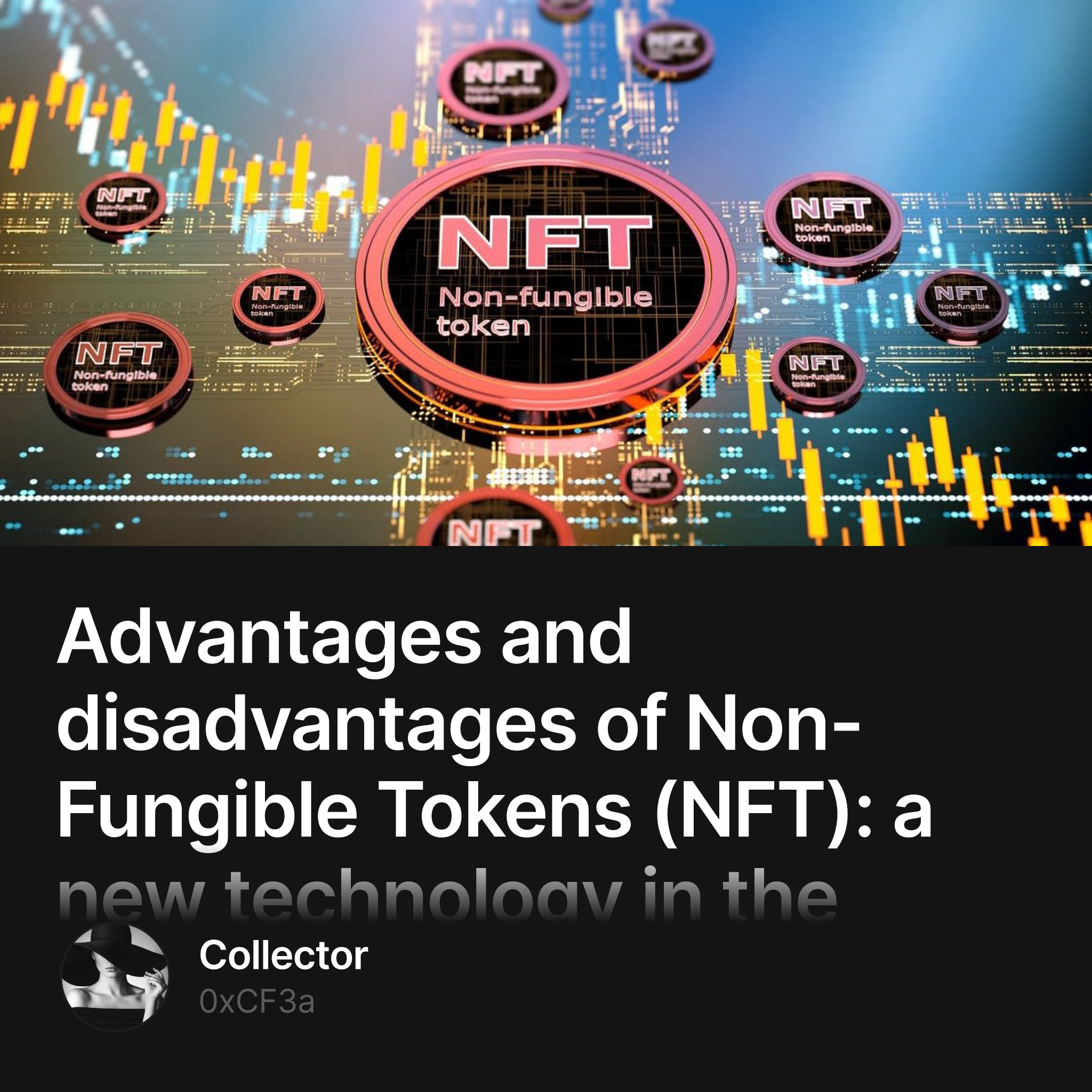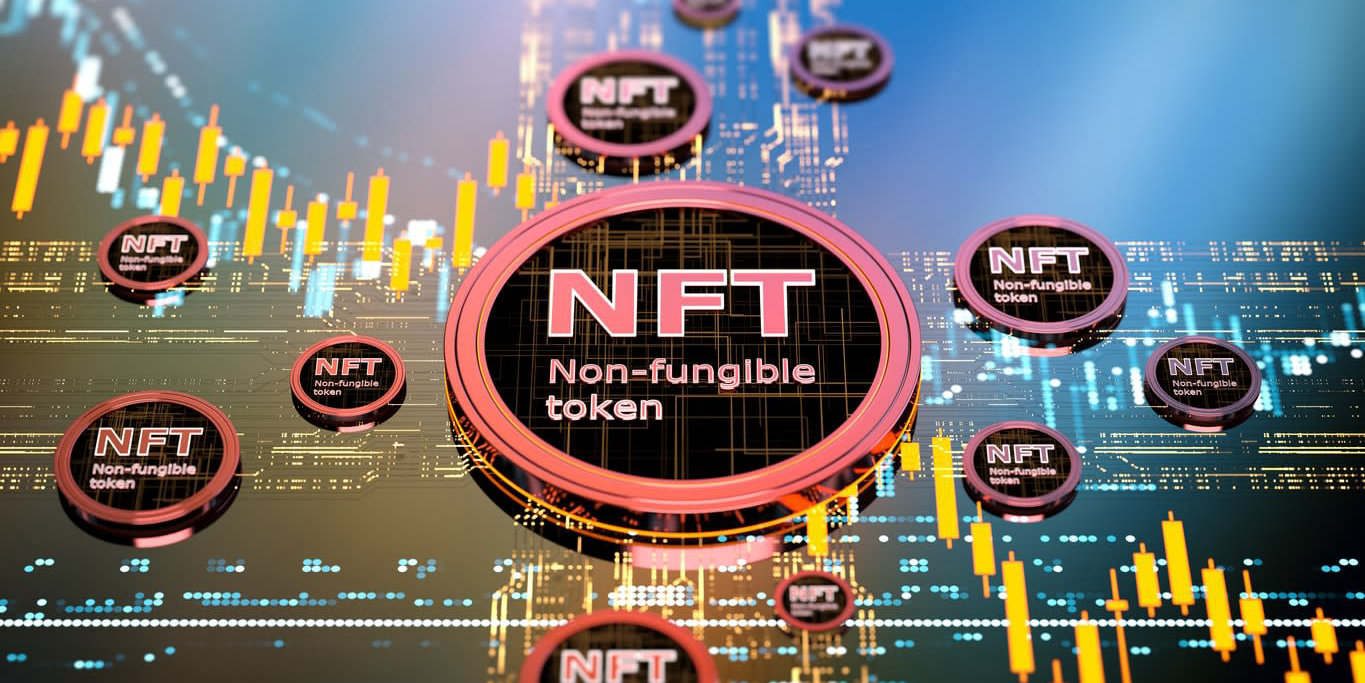In this article, we will consider the following questions:
• What are NFTs and how do they work?
• What are the advantages of NFTs: uniqueness, transparency.
• What are the downsides of NFTs: high fees, environmental concerns, risks of owning digital assets, etc.?
• How NFTs have changed the world of digital assets and what are the prospects for them
• What advice would you give to people who want to get started with the NFT?
Such an article will help readers understand what NFTs are, what opportunities they provide, and what risks may accompany their use.
Non-Fungible Tokens (NFT) are digital assets, each of which has a unique identifier, similar to a serial number. This distinguishes them from Fungible Tokens such as cryptocurrencies, where each unit has the same value and is fungible. NFTs use blockchain technology, which ensures transparency and reliability of transactions. When an NFT is created, a digital record is created that stores metadata about the asset, such as author, creation date, size, and so on. NFTs can be sold, bought and exchanged on various platforms using cryptocurrencies.
What are the advantages of NFT:
• uniqueness
• transparency
• the ability to authenticate
One of the main advantages of NFTs is their uniqueness. NFTs are digital assets, each with a unique identifier, making them exclusive and unique. In addition, thanks to blockchain technology, NFTs provide transparency and authenticity. This allows you to make sure that the digital asset is not counterfeit and has a history of ownership.
What are the disadvantages of the NFT?
• high commissions
•ecological problems
• risks of owning digital assets
One disadvantage of NFTs is the high cost of transactions and fees that are charged when selling and buying NFTs on platforms. This can be intimidating for many users. Also, the use of NFT in the digital sphere can cause environmental problems, since cryptocurrency mining is an energy-intensive process. In addition, the possession of digital assets can also be associated with risks, for example, loss of access to the wallet or theft.
How have NFTs changed the world of digital assets and what are the prospects for them in the future?
NFTs have changed the world of digital assets by making it possible to create and sell unique digital assets such as collectibles, artwork, game items and more. This gives creators the opportunity to profit from their digital works and gives buyers the opportunity to purchase exclusive digital assets. NFTs also help address the issues of forgery and theft of digital works, as each NFT has a unique identifier. In the future, NFTs may become more popular as they allow the creation of unique digital assets and provide the opportunity to sell them. It is also possible that NFTs will be used in other areas, for example, to create digital property rights for real estate or other types of assets.
What advice can you give to people who want to start working with the NFT?
If you want to get started with NFTs, then you should familiarize yourself with the various platforms on which you can create, sell, and buy NFTs. It is also important to understand how blockchain technology works and how the use of NFTs can affect your financial security. When buying NFTs, it is necessary to verify the authenticity of the asset and make sure that the seller has full right to sell.
All in all, dealing with NFTs can be fun and lucrative, but it's important to remain cautious and not take risks. How are NFTs related to ecology and sustainability? Like most digital technologies, NFTs have their own environmental footprint due to the use of energy in computing tasks. Some studies have shown that the process of creating NFTs can be energy intensive and have a high carbon footprint. However, there are opinions that NFTs can help solve the problem of counterfeiting and theft of digital assets, which can ultimately lead to savings in energy and resources. Some NFT platforms, such as Tezos, are working to reduce their ecological footprint by using Proof of Stake instead of Proof of Work, which consumes less energy. It is also important to note that NFTs can have a positive contribution to economic and financial sustainability by supporting new and innovative economies.
How can NFTs affect the future of property and copyright?
NFTs can change the way we own and transfer ownership of digital assets. In addition, they can help solve the problems of counterfeiting and theft of digital assets. NFTs can also improve copyright by allowing authors to control the use of their digital works and profit from their sale. However, there are concerns that NFTs could make copyright even more controlled and restricted, and make digital works even more difficult for the public to access.
How can NFTs affect the arts and entertainment industry?
NFTs already have a significant impact on the arts and entertainment industry, providing an opportunity to sell unique digital works and game items. In the future, NFTs may become even more popular, leading to the creation of new digital works and the development of new forms of entertainment. NFTs can also help improve income for artists, musicians, and other creatives by allowing them to sell their work directly to buyers without a middleman. However, there are concerns that NFTs could lead to further commercialization of the arts and entertainment, which could lead to a reduction in the quality of works and a widening gap between artists and the public. There are also concerns that NFTs could lead to the creation of monopolies on digital works, which could limit the availability and diversity of digital works.
How can NFTs affect the economy?
NFTs can help create new and innovative economies by allowing artists to sell their work directly to buyers without the need for a middleman. This can help improve earnings for creatives and make them more independent from big companies. NFTs can also help improve the transparency and efficiency of digital asset trading. However, there are fears that NFTs could become the target of speculation and create financial bubbles. Some critics believe that the NFT market is already booming and that many NFTs may be overvalued. There are also concerns that NFTs could become the target of fraud and theft, which could harm investors and artists.
How can NFTs help transcend borders and improve the accessibility of cultural heritage?
NFTs can help improve the accessibility of cultural heritage by allowing it to be digitized and shared online. NFTs can also help preserve cultural heritage and prevent its loss due to natural disasters or military conflicts. However, there are concerns that NFTs may lead to further commercialization of cultural heritage and its exploitation for commercial purposes without regard to historical or cultural value. In addition, there is a risk that the digitalization of cultural heritage may infringe copyright and property rights.
NFTs have great potential for further development, especially in the context of the growing popularity of digital technologies. NFTs can help improve the accessibility and accessibility of digital works, as well as improve the economy and finances for creatives. However, for NFTs to realize their potential, a number of challenges need to be addressed, including security, privacy and property rights issues.
What advice can you give to those who want to start working with the NFT?
For those who want to get started with the NFT, it is important to first study the topic well and understand its basics. You need to learn how to create, sell and buy NFTs, as well as how to protect your property rights and prevent fraud.
The next step will be to create and sell their own NFTs. To do this, you need to determine the value of your work and find suitable platforms for sale. It's also important to set rules for using your work to protect your property rights.
In general, NFTs represent a new and innovative form of creating, selling and buying digital works. They have their advantages and disadvantages, but promise to improve the accessibility and accessibility of digital works, as well as improve the economy and finances for creatives.
What platforms exist for selling and buying NFTs?
Today, there are many platforms for selling and buying NFTs. Some of them include:
• OpenSea: one of the most popular platforms for selling and buying NFTs. Here you can find everything from digital paintings to music and video.
• Rarible: Another popular platform for creating, selling and buying NFTs. Here you can sell any work, from digital paintings to GIF animation.
• SuperRare: a platform that focuses on artwork. Here you can find unique digital paintings, audio and video.
• Nifty Gateway: A platform that focuses on collectibles such as sports cards and art.
• Foundation: a platform that focuses on artists and designers. Here you can find unique digital paintings, audio and video.
Examples of successful NFT sales
There are many examples of successful NFT sales, including:
-
Digital work "Everydays: The First 5000 Days" by artist Beeple was sold at Christie's for $69 million.
-
A tweet from Twitter creator Jack Dorsey was sold in NFT form for $2.9 million.
-
A picture of a little girl, drawn by artist Mike Winkelmann, was sold for 69,346 ETH (over $170 million) on the Nifty Gateway platform.
How can NFTs change the world and our economy?
NFTs can bring revolutionary changes to the digital world and economy. They can help authors and creatives protect their property rights and earn more income from their work. NFTs can also improve the accessibility and accessibility of digital works, improve the economy and finance for creatives, and help combat counterfeiting.
Are there risks associated with investing in NFTs?
As with any other form of investment, investing in NFTs comes with certain risks.
• High volatility: the price of NFTs can fluctuate significantly and change rapidly depending on supply and demand.
• Lack of regulation: NFTs are currently not regulated by any central authority or body. This means that investors cannot fully protect their interests and rights.
• Low liquidity: It can be difficult to sell NFTs, especially if demand for the asset falls.
• Fraud risk: There is a risk that NFTs may be counterfeit or may not have the proper rights to sell.
What are the prospects for the development of the NFT?
At the moment, NFTs are at an early stage of development, but they have great potential for growth and development in the future. Some of the possible directions for development include:
• Use of NFTs as unique markers for physical goods, allowing traceability of their origin and history.
• Creation of digital ecosystems in which NFTs are used as digital keys to access various services.
• Development of games and virtual reality using NFT to create unique and inimitable items and assets within games.
• Use of the NFT as an alternative to traditional financing methods such as IPOs and crowdfunding.
Before you start investing in NFTs, you need to consider the risks and conduct a thorough market analysis. Some of the important issues to consider include:
-
Which platform to use to buy and sell NFTs?
-
How to analyze the price and predict the future price?
-
How to verify the authenticity and legitimacy of NFTs?
-
How to secure your NFTs and personal data? Investing in NFTs requires some technical knowledge, such as the ability to work with cryptocurrency wallets and smart contracts. It is also important to understand how the NFT market works in order to determine the appropriate investment strategy and mitigate risks.
All in all, the NFT enjoys a new and interesting way of owning and trading digital assets. However, investors should be careful and dangerous, especially in connection with the development of this market. Investing in NFTs can be interesting and profitable, but only if you take into account the risks and conduct a thorough market analysis.

